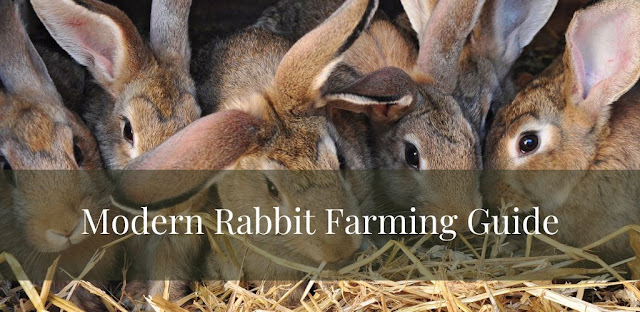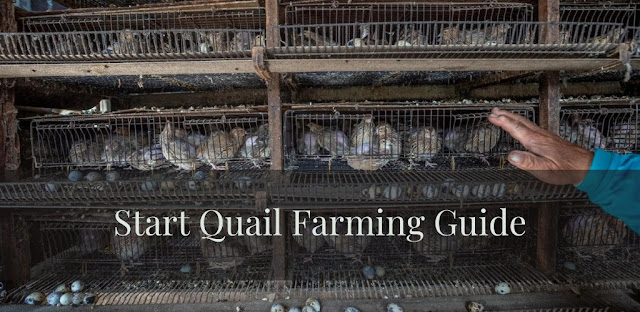Modern Rabbit Farming Guide To Maximum Profitable
The selection of the main stock is the first and most basic step towards the success or failure of a rabbit operation. Naturally, the appearance of the animal will play a major factor in the selection process.
Other important requirements are health, strength, longevity, ability to reproduce, and desired breed and conformation. However, on the whole, the main criterion remains the record of the rabbits. It is very important to study records of family production, heredity, animal size, growth potential, etc. Therefore, buy your foundation stock from a reliable and well-established rabbit that keeps the records.
Rabbit Farming Guide
Breeding Management
If it is 4 months old or older, check it regularly for reception (vulva turns purple or red).
The following are guidelines for nurseries:
- Breeding is initially carried out at 5 months of age for small breeds and 6 months of age for medium breeds.
- Use mature money at the age of 6 months.
- Breed in the morning or evening.
- Take the doe to the deer cage for servicing, let it be serviced repeatedly for up to 10 minutes; return the doe to her cage. If the doe fights, hold her to serve.
- If the buck fails to serve the doe in the minimum time, switch the doe to another buck.
- Palpate the female rabbit 10-14 days after breeding to see if the female rabbit is pregnant. A female deer that is not pregnant at 14 days should be regularly checked for admission (vulvar reddening) in order to return it for service with money.
- The amount of money required depends on the size of the herd. Generally, a male should only be bred once per day. Overweight rabbits, both male and female, make poor breeders. In general, save a dollar for every 10 dollars.
- The average gestation period is 31 days. A day or two on both sides is possible.
- Replace a rooster when his record shows low production, or the offspring show poor feed conversion or poor weight gain.
- Keep replacement stock for expansion as needed to keep the cage stocked with work tools and active money. Keep increasing the herd with low producer strict extermination.
- The average production life of an item is about 2-3 years, but saving on the production of goods during production guarantees it.
- The average production life of good money is from one to five years.
- Save at least one young doe and money per month for every 12 jobs done at the end of the second or third year, if replacement is needed. This level of reimbursement will generally not cover culling and death. Refill stock as needed.
- Occasionally buy good money from an established and reliable farm to prevent extreme crossbreeding.
Rabbit Health Management
Disease Prevention/Control
- Sanitary conditions for rabbit cages, cages and equipment that are clean, balanced feed and fresh clean water are very important to prevent possible infection.
- Rabbits should be prevented from coming into contact with their droppings.
- Overcrowding should be avoided.
- Proper ventilation should be provided.
- Flies that can act as carriers of infection should be controlled in the rabbit cage.
- Common rabbit diseases and recommended preventive/control measures.
- Rabbit cages should be disinfected with a blow light after each shearing cage and firewood before moving rabbits and after weaning.
- Burning the sick and dead rabbits so that the disease does not spread.
- Nest box beds should be burned after use.
- Dead animals should be buried immediately after post mortem (if necessary).
Youth care
- Nest box should be removed after 5 weeks of firewood.
- Kits should be inspected and dead ones should be removed daily.
- If wet sheets must be replaced with new and clean ones.
- Weaning should be done at 5 or 6 weeks after weaning.
- It is not recommended to change the feed suddenly.
Irrigation
- Water should be available at all times especially for nursing female rabbits.
- Always provide fresh and clean drinking water.
- Always keep the water pot clean and remove sediment every day. The water pot should be cleaned thoroughly every week.
- The use of well-designed automatic watering equipment is also possible.
Equipment
- Use scientifically designed cages and equipment. The ideal size for the cage floor is 14-16 with a mesh size of 19x19 mm or 25x13 mm. Walls and roofs can be built with lighter sizes of 16-20 with a mesh size of 25x25mm.
- The feeder should be designed and placed so that the feed can be poured from the outside and should be 5-7.5 cm in size. on the floor of the cage to avoid contamination by urine, faeces or water. The edge of the feeder should be rounded and turned in ” to prevent the rabbit from spilling feed/water.
- Watering equipment 400-500 ml. capacities made of aluminium, earth or other less expensive locally available materials may be used.
Location and Housing
- Areas that have temperatures ranging between 10o C and 20o C and relative humidity between 55 and 65% all year round are ideal for rearing Angora rabbits.
- Ensure adequate facilities for clean water, electricity, road access, livestock supplies, feed, animal feed, veterinary assistance and proximity to markets for the sale of wool and meat from culled animals.
- For small size rabbit farms a cage system can be adopted which is a self contained cage-nest box with it's own roof.
- In the case of larger farms, cages can be arranged within the pen in one or two levels under a hanging or step wise shelving system.
- Provide adequate floor space for each rabbit. Space requirements (cage size) for different categories of rabbits.
- Rabbit roofs should be made of wood, thatch or other cheaper local materials.
- Build the cage in such a way that predators and birds do not enter the cage. In the case of open cages, proper fencing should be provided to protect the rabbits from predators.
- Build a rat-proof civil structure for wool feed and storage.
- Keep the cage/cage clean by cleaning and disinfecting it regularly to keep it free from flies/mosquitoes and the place to enter the cage must be kept clean.
- Rabbit cages should be cleaned regularly, especially disinfected before burning.
- During the firewood period, the cage/nest box must be kept clean so that the kit does not contract diseases such as coccidia.
- Feeders and drinking bins should be cleaned regularly and ground feed should be removed from feeders that can be used to feed other livestock species.
Rabbit Market
Rabbit Meat
Being the best white meat, the demand for rabbit meat is increasing in the local market. Most hotels in Kenya are willing to include rabbit meat in their menus, but the challenge is always a constant source of maintaining demand.
The only available rabbit meat is obtained from farmers who produce rabbits for breeding but are forced to reduce the extra money generated and are not needed for breeding purposes. A kilo of rabbit meat ranges between Kshs.500.00 and 10000.00 at the local market. The export market is not mentioned because we are far from reaching production capacity. Several NGOs are working on modalities to increase production through sensitivity campaigns and funding to existing farmers. The World Bank and financial institutions (eg Equity Bank) have a common interest in rabbit farming through small rabbit breeder groups.
Rabbit Breeding
This has become the largest market locally due to the increasing number of new middle class farmers who are starting on a large scale after realizing the potential and high profits of the business. A one month rabbit earns between Kshs.500 to 1000. Each additional month increases its value by Kshs.1000 with a 5 month old rabbit ranging from Kshs.3500 to 5000 depending on breed, health and region.
Rabbit For Laboratory use
This is the best market for rabbits due to the fact that export businesses have relatively higher returns once the market is established. A farmer has exported live rabbits to a pharmaceutical manufacturing company in South Africa for Kshs.15.000,00 for a 3 month old rabbit. A prominent politician in the Central Province has built his own market for companies in China and Egypt.
Rabbit Urine
Rabbit urine is used as a direct insecticide. However, this market was not exploited due to small production and poor house design. Modern self-cleaning cages have a urine collection system that ensures nothing is wasted. Local greenhouse farmers buy urine at Kshs.50.00 per liter which they dilute in a 1:5 ratio in water and spray directly on their crops.
Rabbit Poop
Being the best composite fertilizer with the highest ammonia and nitrate content, 20 kg sack rabbit manure costs Shs.50. Most of the farmers prefer to use it in farming rather than selling. Fresh rabbit droppings serve as tilapia food for those with fish ponds.
Rabbit Skin
Rabbit skin is used in the manufacture of ornaments in Asian countries and is the best in the manufacture of fishing gear, rabbit skin is sold for Kshs.300. Proper training on slaughter is very important because the quality of the skin depends on the care during slaughter.

.jpg)


Komentar
Posting Komentar